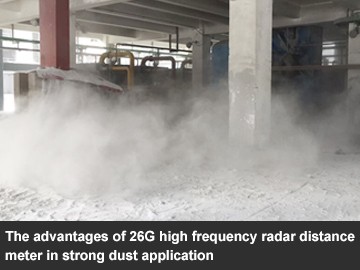26G high frequency radar distance meter used in strong dust
Today we share the practical case of the level measurement of the 26G high frequency radar distance meter in the limestone storage desulfurization device of the electric heating plant. The customer originally used a guided wave radar cable-type level meter to measure the raw material level of the limestone silo in the electric heating plant, and encountered frequent measurement defects, which caused a lot of inconvenience to production. Therefore, in this case, we propose to adopt the 26G high-frequency radar level sensor suitable for non-contact measurement in high dust environment, and finally achieved a very satisfactory result.
In this case, the reason why the 26G high frequency radar distance meter can solve the difficulties in this measurement is mainly because it is more suitable for level measurement in a strong dust environment. The high-frequency radar sensor is a non-contact measurement, which is less affected by the temperature and pressure of the measured medium; the antenna size is small and easy to install; the microwave antenna has a small beam angle, which can effectively detect irregular materials and avoid obstacles that affect the measurement effect, and case smaller errors; microwave energy is concentrated, which can effectively penetrate the dust, and the precision value reaches ± 15mm. At the same time, for the conical flat-top warehouse, we install the best position of the high frequency radar level meter at the top center to ensure accurate measurement to the bottom of the container. Finally, remind the production personnel to avoid the material inlet and outlet, and do a good job of sealing and waterproofing. The results prove that the high-frequency radar provides accurate and reliable data for continuous detection and high-low detection of the production process of the electric heating plant. The wave radar cable-type material level meter has a false material level that does not change the material level and swings when loading and unloading and when the negative pressure fan operates because the cable absorbs the medium. In the actual blanking process, due to the large amount of dust, the waveguide cable is often stuck, so that the false signal or the signal from the full warehouse does not change. It seriously affected the measurement result and so it was replaced.
It should be noted that although the 26G high frequency radar level distance meter has a great advantage in the measurement environment of strong dust, its waterproof rating is IP67, so it is not suitable for rainy weather or tropical rain forests. And the radar level meter has a certain blind zone, the larger the range, the larger the blind zone, so we need to consider comprehensively when choosing this level timing.






